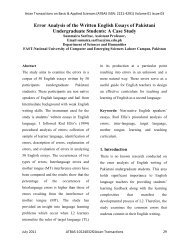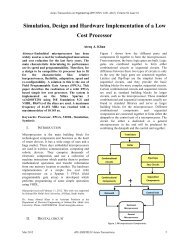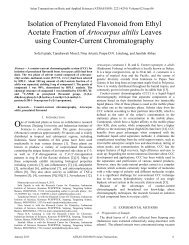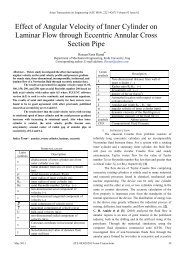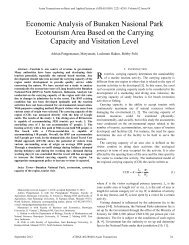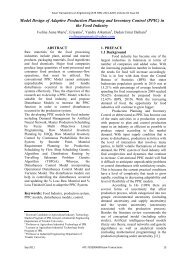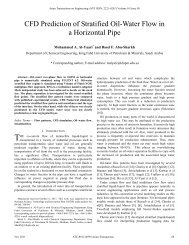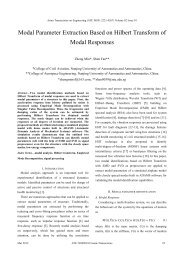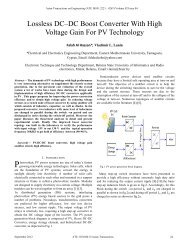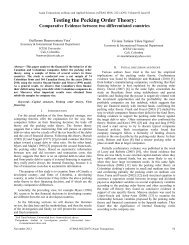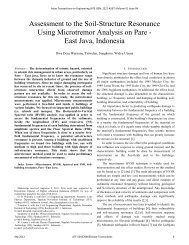Role of Organic Matter in Mitigation of Pesticides on Cabbage ...
Role of Organic Matter in Mitigation of Pesticides on Cabbage ...
Role of Organic Matter in Mitigation of Pesticides on Cabbage ...
Create successful ePaper yourself
Turn your PDF publications into a flip-book with our unique Google optimized e-Paper software.
Asian Transacti<strong>on</strong>s <strong>on</strong> Basic and Applied Sciences (ATBAS ISSN: 2221-4291) Volume 02 Issue 05<str<strong>on</strong>g>Role</str<strong>on</strong>g> <str<strong>on</strong>g>of</str<strong>on</strong>g> <str<strong>on</strong>g>Organic</str<strong>on</strong>g> <str<strong>on</strong>g>Matter</str<strong>on</strong>g> <str<strong>on</strong>g>in</str<strong>on</strong>g> <str<strong>on</strong>g>Mitigati<strong>on</strong></str<strong>on</strong>g> <str<strong>on</strong>g>of</str<strong>on</strong>g><str<strong>on</strong>g>Pesticides</str<strong>on</strong>g> <strong>on</strong> <strong>Cabbage</strong> [Brassica oleracea (L.)]Cropp<str<strong>on</strong>g>in</str<strong>on</strong>g>gSaartje Sompotan, Za<str<strong>on</strong>g>in</str<strong>on</strong>g>al Kusuma, Budi Prasetyo, and Jeany Polii-MandangAbstract—The use <str<strong>on</strong>g>of</str<strong>on</strong>g> pesticides to <str<strong>on</strong>g>in</str<strong>on</strong>g>crease agriculturalproductivity is very worry<str<strong>on</strong>g>in</str<strong>on</strong>g>g. Excessive applicati<strong>on</strong> <str<strong>on</strong>g>of</str<strong>on</strong>g> pesticidewill leave residues <str<strong>on</strong>g>in</str<strong>on</strong>g> the soil giv<str<strong>on</strong>g>in</str<strong>on</strong>g>g a negative impact <strong>on</strong> theenvir<strong>on</strong>ment. So that mitigati<strong>on</strong> measures to restore soilc<strong>on</strong>diti<strong>on</strong>s are very important. Study <strong>on</strong> pesticide mitigati<strong>on</strong> us<str<strong>on</strong>g>in</str<strong>on</strong>g>gchicken manure organic matter <strong>on</strong> cabbage crop has beenc<strong>on</strong>ducted with a randomized block design arranged <str<strong>on</strong>g>in</str<strong>on</strong>g> factorial.Factor A was an organic fertilizer with three doses and factor Bwas the use <str<strong>on</strong>g>of</str<strong>on</strong>g> pesticides Proclaim® 5 SG with five doses andspray<str<strong>on</strong>g>in</str<strong>on</strong>g>g variati<strong>on</strong>s <str<strong>on</strong>g>of</str<strong>on</strong>g> up to 20 times applicati<strong>on</strong>s. The studyexam<str<strong>on</strong>g>in</str<strong>on</strong>g>ed the <str<strong>on</strong>g>in</str<strong>on</strong>g>teracti<strong>on</strong> between pesticides with organic mattersby measur<str<strong>on</strong>g>in</str<strong>on</strong>g>g the levels <str<strong>on</strong>g>of</str<strong>on</strong>g> pesticides after treatments. Data wereanalyzed with analysis <str<strong>on</strong>g>of</str<strong>on</strong>g> variance and c<strong>on</strong>t<str<strong>on</strong>g>in</str<strong>on</strong>g>ued with LSD 5%.The results showed a positive <str<strong>on</strong>g>in</str<strong>on</strong>g>teracti<strong>on</strong> between organic matterand pesticide residues result<str<strong>on</strong>g>in</str<strong>on</strong>g>g <str<strong>on</strong>g>in</str<strong>on</strong>g> a reducti<strong>on</strong> <str<strong>on</strong>g>in</str<strong>on</strong>g> the levels <str<strong>on</strong>g>of</str<strong>on</strong>g>residues <str<strong>on</strong>g>in</str<strong>on</strong>g> the soil. The low residue was obta<str<strong>on</strong>g>in</str<strong>on</strong>g>ed <strong>on</strong> treatment <str<strong>on</strong>g>of</str<strong>on</strong>g>8 t<strong>on</strong>s <str<strong>on</strong>g>of</str<strong>on</strong>g> organic matter without spray<str<strong>on</strong>g>in</str<strong>on</strong>g>g pesticide, and thehighest residue was found <str<strong>on</strong>g>in</str<strong>on</strong>g> treatment comb<str<strong>on</strong>g>in</str<strong>on</strong>g>ati<strong>on</strong> with noorganic matter and 2.0 g pesticide with 20 times spray<str<strong>on</strong>g>in</str<strong>on</strong>g>g, whichwas 27.59 mg/kg. Residue <strong>on</strong> cabbage plants measured between1.3 and 5.9 mg/kg.Index Terms— pesticides, mitigati<strong>on</strong>, Proclaim® 5 SG, cabbageAI. INTRODUCTIONN <str<strong>on</strong>g>in</str<strong>on</strong>g>creas<str<strong>on</strong>g>in</str<strong>on</strong>g>g number <str<strong>on</strong>g>of</str<strong>on</strong>g> populati<strong>on</strong> <str<strong>on</strong>g>in</str<strong>on</strong>g> Ind<strong>on</strong>esia fromyear to year leads to the need for more food. The grow<str<strong>on</strong>g>in</str<strong>on</strong>g>gneed for food such as vegetables not <strong>on</strong>ly is <str<strong>on</strong>g>in</str<strong>on</strong>g> every family,but also at homes and restaurants. A grow<str<strong>on</strong>g>in</str<strong>on</strong>g>g number <str<strong>on</strong>g>of</str<strong>on</strong>g>restaurants means the demand <strong>on</strong> vegetables, such as cabbage,also is <str<strong>on</strong>g>in</str<strong>on</strong>g>creased.<strong>Cabbage</strong> was orig<str<strong>on</strong>g>in</str<strong>on</strong>g>ally planted <str<strong>on</strong>g>in</str<strong>on</strong>g> gardens <str<strong>on</strong>g>in</str<strong>on</strong>g> Europe <str<strong>on</strong>g>in</str<strong>on</strong>g> the9th century and brought to America by European immigrantsand other parts <str<strong>on</strong>g>of</str<strong>on</strong>g> the world, <str<strong>on</strong>g>in</str<strong>on</strong>g>clud<str<strong>on</strong>g>in</str<strong>on</strong>g>g Ind<strong>on</strong>esia, <str<strong>on</strong>g>in</str<strong>on</strong>g> 16th or17th century. In earlier days, the cabbage was grown for itsManuscript received October 9, 2012; accepted November 13, 2012.S. Sompotan is with the Postgraduate Program, Faculty <str<strong>on</strong>g>of</str<strong>on</strong>g> Agriculture,Brawijaya University, Jl. Veteran 2, Malang 65145, East Java, Ind<strong>on</strong>esia; andFaculty <str<strong>on</strong>g>of</str<strong>on</strong>g> Agriculture, Sam Ratulangi University, Jl. Kampus Kleak, Manado95115, North Sulawesi, Ind<strong>on</strong>esia (corresp<strong>on</strong>d<str<strong>on</strong>g>in</str<strong>on</strong>g>g author, ph<strong>on</strong>e +62-81244095007, e-mail: johntooy@yahoo.co.id).Z. Kusuma and B. Prasetya are with the Faculty <str<strong>on</strong>g>of</str<strong>on</strong>g> Agriculture, BrawijayaUniversity, Jl. Veteran 2, Malang 65145, East Java, Ind<strong>on</strong>esia.J. Polii-Mandang is with the Faculty <str<strong>on</strong>g>of</str<strong>on</strong>g> Agriculture, Sam RatulangiUniversity, Jl. Kampus Kleak, Manado 95115, North Sulawesi, Ind<strong>on</strong>esia.seeds. Later people began to c<strong>on</strong>sume the leaves. <strong>Cabbage</strong>(Brassica oleracea L.) is grouped <str<strong>on</strong>g>in</str<strong>on</strong>g> Capitata. The leaves arearranged very tightly to form crops.<strong>Cabbage</strong> can grow optimally at an altitude <str<strong>on</strong>g>of</str<strong>on</strong>g> 200–2000meters above sea level (masl). For upland varieties, cabbagegrows well at altitudes 1000–2000 masl. Although it isrelatively resistant to high temperatures, its producti<strong>on</strong> wouldbe maximum if the cabbage is grown <str<strong>on</strong>g>in</str<strong>on</strong>g> the tropical highlands,i.e. at an altitude <str<strong>on</strong>g>of</str<strong>on</strong>g> 400 masl and above with a large cropyield, while <str<strong>on</strong>g>in</str<strong>on</strong>g> lowland crop size is smaller.The diam<strong>on</strong>dback moth (DBM) larvae [Plutella xylostella(L.)] are <strong>on</strong>e <str<strong>on</strong>g>of</str<strong>on</strong>g> the major pests <str<strong>on</strong>g>in</str<strong>on</strong>g> cabbage crops. Thecaterpillars eat the bottom part <str<strong>on</strong>g>of</str<strong>on</strong>g> leaves and leave the upperepidermis. Various methods have been pursued to eradicatesuch pest, for example by plant<str<strong>on</strong>g>in</str<strong>on</strong>g>g pest-resistant varieties, croprotati<strong>on</strong>, simultaneous plant<str<strong>on</strong>g>in</str<strong>on</strong>g>g, and use <str<strong>on</strong>g>of</str<strong>on</strong>g> pesticides [1, 2].The use <str<strong>on</strong>g>of</str<strong>on</strong>g> pesticides, especially <str<strong>on</strong>g>of</str<strong>on</strong>g> synthesis, is the mostwidespread as it is c<strong>on</strong>sidered fast and powerful <str<strong>on</strong>g>in</str<strong>on</strong>g> tackl<str<strong>on</strong>g>in</str<strong>on</strong>g>g thepests. However, its use is result<str<strong>on</strong>g>in</str<strong>on</strong>g>g <str<strong>on</strong>g>in</str<strong>on</strong>g> negative impacts, such aspest resistance, pest resurgence, kill<str<strong>on</strong>g>in</str<strong>on</strong>g>g natural enemies andenvir<strong>on</strong>mental polluti<strong>on</strong> problems and is very harmful tohumans [3-6].Pest attack usually comes dur<str<strong>on</strong>g>in</str<strong>on</strong>g>g high ra<str<strong>on</strong>g>in</str<strong>on</strong>g>fall seas<strong>on</strong>,because the water c<strong>on</strong>tent <str<strong>on</strong>g>in</str<strong>on</strong>g> the leave attracts pests, such asPlutella caterpillars. Tomoh<strong>on</strong> area is an excellent place forcabbage plantati<strong>on</strong>, but ra<str<strong>on</strong>g>in</str<strong>on</strong>g>fall <str<strong>on</strong>g>in</str<strong>on</strong>g> the area is very high. Datafrom the Meteorology and Geophysics Agency at Tomoh<strong>on</strong>show the average ra<str<strong>on</strong>g>in</str<strong>on</strong>g>fall from 2007 to 2009 was 626.7 mL.This situati<strong>on</strong> can lead cabbage c<strong>on</strong>ta<str<strong>on</strong>g>in</str<strong>on</strong>g> lots <str<strong>on</strong>g>of</str<strong>on</strong>g> fluids and beeasily attacked by pests; especially Plutella sp. Plutellacaterpillars eat cabbage leaves result<str<strong>on</strong>g>in</str<strong>on</strong>g>g <str<strong>on</strong>g>in</str<strong>on</strong>g> holes <strong>on</strong> leaves andthus decrease quality and quantity <str<strong>on</strong>g>of</str<strong>on</strong>g> crop yields.S<str<strong>on</strong>g>in</str<strong>on</strong>g>ce late 80s when the rapid development <str<strong>on</strong>g>of</str<strong>on</strong>g> pesticides,pesticide use was also grow<str<strong>on</strong>g>in</str<strong>on</strong>g>g, either <str<strong>on</strong>g>in</str<strong>on</strong>g> type comb<str<strong>on</strong>g>in</str<strong>on</strong>g>ati<strong>on</strong>s or<str<strong>on</strong>g>in</str<strong>on</strong>g>crease <str<strong>on</strong>g>in</str<strong>on</strong>g> c<strong>on</strong>centrati<strong>on</strong>/dose. Pesticide is used from wellbefore the attack up to the occurrence <str<strong>on</strong>g>of</str<strong>on</strong>g> pests. However, theuse <str<strong>on</strong>g>of</str<strong>on</strong>g> pesticides is like a double-edged sword, <strong>on</strong> the <strong>on</strong>e handit <str<strong>on</strong>g>in</str<strong>on</strong>g>hibit plant pests thus <str<strong>on</strong>g>in</str<strong>on</strong>g>creas<str<strong>on</strong>g>in</str<strong>on</strong>g>g crop producti<strong>on</strong>, but <strong>on</strong>the other side it can upset the balance and health <str<strong>on</strong>g>of</str<strong>on</strong>g> the soil.This is due to pesticide residues <strong>on</strong> plants and <str<strong>on</strong>g>in</str<strong>on</strong>g> the soil canlead to death <str<strong>on</strong>g>of</str<strong>on</strong>g> the n<strong>on</strong>-target predators. One example <str<strong>on</strong>g>of</str<strong>on</strong>g> thec<strong>on</strong>sequences <str<strong>on</strong>g>of</str<strong>on</strong>g> the effect <str<strong>on</strong>g>of</str<strong>on</strong>g> pesticides <strong>on</strong> <str<strong>on</strong>g>in</str<strong>on</strong>g>sects and birdsthat is caused by the toxic effects <str<strong>on</strong>g>of</str<strong>on</strong>g> pesticides, usually 2-3November 2012 ATBAS-50223051©Asian Transacti<strong>on</strong>s 50
Asian Transacti<strong>on</strong>s <strong>on</strong> Basic and Applied Sciences (ATBAS ISSN: 2221-4291) Volume 02 Issue 05days after plant<str<strong>on</strong>g>in</str<strong>on</strong>g>g <str<strong>on</strong>g>in</str<strong>on</strong>g>sect <str<strong>on</strong>g>of</str<strong>on</strong>g> Gryllotalpidae who <str<strong>on</strong>g>in</str<strong>on</strong>g>tends to eatsprouts from the soil dead <str<strong>on</strong>g>in</str<strong>on</strong>g> mass and ly<str<strong>on</strong>g>in</str<strong>on</strong>g>g <strong>on</strong> the ground.Insect carcasses are <str<strong>on</strong>g>of</str<strong>on</strong>g> course an easy food for Anduhur Bol<strong>on</strong>birds, but at the same it kills the natural c<strong>on</strong>troller bird species.Another impact is the c<strong>on</strong>tam<str<strong>on</strong>g>in</str<strong>on</strong>g>ati<strong>on</strong> <str<strong>on</strong>g>of</str<strong>on</strong>g> the river water whenpesticides used <str<strong>on</strong>g>in</str<strong>on</strong>g> the paddy fields flow with irrigati<strong>on</strong> water<str<strong>on</strong>g>in</str<strong>on</strong>g>to the river. There are pesticides left to dissolve <str<strong>on</strong>g>in</str<strong>on</strong>g> thesurface water flow, c<strong>on</strong>ta<str<strong>on</strong>g>in</str<strong>on</strong>g>ed <str<strong>on</strong>g>in</str<strong>on</strong>g> soil and dissolved al<strong>on</strong>g withthe groundwater flow. Water quality is <str<strong>on</strong>g>in</str<strong>on</strong>g>fluenced by thepesticide associated with its presence and level <str<strong>on</strong>g>of</str<strong>on</strong>g> toxicity,where its ability to be transported is a functi<strong>on</strong> <str<strong>on</strong>g>of</str<strong>on</strong>g> its solubilityand soil ability to absorb the particles. In Ind<strong>on</strong>esia the case <str<strong>on</strong>g>of</str<strong>on</strong>g>c<strong>on</strong>tam<str<strong>on</strong>g>in</str<strong>on</strong>g>ati<strong>on</strong> by pesticides causes many losses. In Lembangand Pangalengan the soil around the carrot, tomato, cabbageand bean gardens have been c<strong>on</strong>tam<str<strong>on</strong>g>in</str<strong>on</strong>g>ated by organochlor<str<strong>on</strong>g>in</str<strong>on</strong>g>eresidues. The Cimanuk river water is also polluted byagricultural chemicals. In agriculture, the emamect<str<strong>on</strong>g>in</str<strong>on</strong>g> benzoatepesticide is a semi-fermented and semi-synthesized and isenvir<strong>on</strong>ment-friendly pesticide classified as biologicalpesticides.Proclaim® 5 SG with active <str<strong>on</strong>g>in</str<strong>on</strong>g>gredient emamect<str<strong>on</strong>g>in</str<strong>on</strong>g> benzoateis a semi-fermented and semi-synthesized <str<strong>on</strong>g>in</str<strong>on</strong>g>secticide fromavermect<str<strong>on</strong>g>in</str<strong>on</strong>g> type [7, 8]. Emamect<str<strong>on</strong>g>in</str<strong>on</strong>g> is made up <str<strong>on</strong>g>of</str<strong>on</strong>g> emamect<str<strong>on</strong>g>in</str<strong>on</strong>g>B1A and emamect<str<strong>on</strong>g>in</str<strong>on</strong>g> B1b, and is produced <str<strong>on</strong>g>in</str<strong>on</strong>g> the form <str<strong>on</strong>g>of</str<strong>on</strong>g>emamect<str<strong>on</strong>g>in</str<strong>on</strong>g> benzoate, a mixture <str<strong>on</strong>g>of</str<strong>on</strong>g> benzoic acid salt <str<strong>on</strong>g>of</str<strong>on</strong>g> the twocomplex structures heterocyclic compounds. Benzoic acid salt<str<strong>on</strong>g>of</str<strong>on</strong>g> 4'-epi-methylam<str<strong>on</strong>g>in</str<strong>on</strong>g>o-4'-19 deoxyavermect<str<strong>on</strong>g>in</str<strong>on</strong>g> B1A and 4"-epimethylam<str<strong>on</strong>g>in</str<strong>on</strong>g>o-4'-deoxyavermect<str<strong>on</strong>g>in</str<strong>on</strong>g>B1b (Proclaim 5 SG) iswidely used <str<strong>on</strong>g>in</str<strong>on</strong>g> Tomoh<strong>on</strong> to c<strong>on</strong>trol Plutella pests <strong>on</strong> cabbageplants. However, the use <str<strong>on</strong>g>of</str<strong>on</strong>g> pesticides by farmers <str<strong>on</strong>g>of</str<strong>on</strong>g>ten doesnot comply with the recommendati<strong>on</strong>. Dose and tim<str<strong>on</strong>g>in</str<strong>on</strong>g>g <str<strong>on</strong>g>of</str<strong>on</strong>g>pesticides <str<strong>on</strong>g>of</str<strong>on</strong>g>ten exceed the recommended prescripti<strong>on</strong> so togive negative impacts <strong>on</strong> the envir<strong>on</strong>ment such as residues <str<strong>on</strong>g>in</str<strong>on</strong>g>soil and plants.To address the pesticide c<strong>on</strong>tam<str<strong>on</strong>g>in</str<strong>on</strong>g>ati<strong>on</strong>, organic matter canbe used as soil that c<strong>on</strong>ta<str<strong>on</strong>g>in</str<strong>on</strong>g>s a lot <str<strong>on</strong>g>of</str<strong>on</strong>g> organic matter has a lot <str<strong>on</strong>g>of</str<strong>on</strong>g>soil microbes to accelerate degradati<strong>on</strong> <str<strong>on</strong>g>of</str<strong>on</strong>g> pesticide residues <str<strong>on</strong>g>in</str<strong>on</strong>g>soil [9]. This manuscript discusses the role <str<strong>on</strong>g>of</str<strong>on</strong>g> organic matter <str<strong>on</strong>g>in</str<strong>on</strong>g>mitigati<strong>on</strong> <str<strong>on</strong>g>of</str<strong>on</strong>g> pesticide residues <str<strong>on</strong>g>in</str<strong>on</strong>g> the soil due to the excessiveuse <str<strong>on</strong>g>of</str<strong>on</strong>g> pesticide.II. MATERIALS AND METHODSThe study was c<strong>on</strong>ducted <str<strong>on</strong>g>in</str<strong>on</strong>g> the village <str<strong>on</strong>g>of</str<strong>on</strong>g> Matani Tomoh<strong>on</strong>with<str<strong>on</strong>g>in</str<strong>on</strong>g> approximately 35 km from the City <str<strong>on</strong>g>of</str<strong>on</strong>g> Manado fromFebruary to December 2012.MaterialsThe materials used were the seeds <str<strong>on</strong>g>of</str<strong>on</strong>g> cabbage, organicchicken manure, and pesticides (<str<strong>on</strong>g>in</str<strong>on</strong>g>secticides) Proclaim® 5 SG(manufactured by PT Syngenta Ind<strong>on</strong>esia).Field ExperimentsThe field experiments were c<strong>on</strong>ducted over four m<strong>on</strong>ths.The study employed a factorial randomized groups design.The study c<strong>on</strong>sisted <str<strong>on</strong>g>of</str<strong>on</strong>g> two factors where the first factor wasthe dose <str<strong>on</strong>g>of</str<strong>on</strong>g> organic matter (A), which c<strong>on</strong>sisted <str<strong>on</strong>g>of</str<strong>on</strong>g> three doselevels:A0 = without chicken manure;A1 = 4 t<strong>on</strong>s <str<strong>on</strong>g>of</str<strong>on</strong>g> chicken manure/ha;A2 = 8 t<strong>on</strong>s <str<strong>on</strong>g>of</str<strong>on</strong>g> chicken manure/ha.The sec<strong>on</strong>d factor was the dose and frequency <str<strong>on</strong>g>of</str<strong>on</strong>g> pesticidespray<str<strong>on</strong>g>in</str<strong>on</strong>g>g (with spray<str<strong>on</strong>g>in</str<strong>on</strong>g>g <str<strong>on</strong>g>in</str<strong>on</strong>g>terval <str<strong>on</strong>g>of</str<strong>on</strong>g> three days) (B), whichc<strong>on</strong>sisted <str<strong>on</strong>g>of</str<strong>on</strong>g> five levels:B0 = without pesticides;B1 = pesticide c<strong>on</strong>centrati<strong>on</strong> <str<strong>on</strong>g>of</str<strong>on</strong>g> 0.5 g/liter <str<strong>on</strong>g>of</str<strong>on</strong>g> water with 5times spray<str<strong>on</strong>g>in</str<strong>on</strong>g>g;B2 = pesticide c<strong>on</strong>centrati<strong>on</strong> <str<strong>on</strong>g>of</str<strong>on</strong>g> 1.0 g/liter <str<strong>on</strong>g>of</str<strong>on</strong>g> water with 10times spray<str<strong>on</strong>g>in</str<strong>on</strong>g>g;B3 = pesticide c<strong>on</strong>centrati<strong>on</strong> <str<strong>on</strong>g>of</str<strong>on</strong>g> 1.5 g/liter <str<strong>on</strong>g>of</str<strong>on</strong>g> water with 15times spray<str<strong>on</strong>g>in</str<strong>on</strong>g>g;B4 = pesticide c<strong>on</strong>centrati<strong>on</strong> <str<strong>on</strong>g>of</str<strong>on</strong>g> 2.0 g/liter <str<strong>on</strong>g>of</str<strong>on</strong>g> water with 20times spray<str<strong>on</strong>g>in</str<strong>on</strong>g>g.Each unit <str<strong>on</strong>g>of</str<strong>on</strong>g> experiment was repeated three times to obta<str<strong>on</strong>g>in</str<strong>on</strong>g>45 experimental lots.Observed Variables- Pesticide residues <str<strong>on</strong>g>in</str<strong>on</strong>g> soil, measured <strong>on</strong>e week beforeharvest.- Pesticide residues <strong>on</strong> cabbage plants, measured at harvest.Residue Analysis The first phase <str<strong>on</strong>g>of</str<strong>on</strong>g> the studyThe first phase <str<strong>on</strong>g>of</str<strong>on</strong>g> the study was sampl<str<strong>on</strong>g>in</str<strong>on</strong>g>g the soil <strong>on</strong>e weekbefore plant<str<strong>on</strong>g>in</str<strong>on</strong>g>g cabbage seeds to obta<str<strong>on</strong>g>in</str<strong>on</strong>g> support<str<strong>on</strong>g>in</str<strong>on</strong>g>g data <strong>on</strong>pesticide residues <strong>on</strong> the soil prior to plantati<strong>on</strong>. Soil sampleswere taken randomly to a depth <str<strong>on</strong>g>of</str<strong>on</strong>g> 30 cm, then wrapped <str<strong>on</strong>g>in</str<strong>on</strong>g>plastic bags and labeled. Analysis <str<strong>on</strong>g>of</str<strong>on</strong>g> pesticide residues <str<strong>on</strong>g>in</str<strong>on</strong>g> soiland plant residue was performed at the Laboratory <str<strong>on</strong>g>of</str<strong>on</strong>g>Agrochemical Material Residue, Research Center forAgricultural Envir<strong>on</strong>ment at Bogor.Analysis Procedure <str<strong>on</strong>g>of</str<strong>on</strong>g> Emamect<str<strong>on</strong>g>in</str<strong>on</strong>g> Benzoate InsecticideResidues <str<strong>on</strong>g>in</str<strong>on</strong>g> Soil and <strong>Cabbage</strong> SamplesResidue exam<str<strong>on</strong>g>in</str<strong>on</strong>g>ati<strong>on</strong> procedures <str<strong>on</strong>g>in</str<strong>on</strong>g> soil and plants were asfollows: soil/cabbage samples as much as 25 grams were put<str<strong>on</strong>g>in</str<strong>on</strong>g>to 500 mL Erlenmeyer flask and dissolved <str<strong>on</strong>g>in</str<strong>on</strong>g> 100 mL <str<strong>on</strong>g>of</str<strong>on</strong>g>acet<strong>on</strong>e and water <str<strong>on</strong>g>in</str<strong>on</strong>g> the ratio (70:30). Later, the soluti<strong>on</strong> wasshaken with an electric shaker for 2 hours and then filteredwith a 500 mL separat<str<strong>on</strong>g>in</str<strong>on</strong>g>g funnel. The collected extracts werepartiti<strong>on</strong>ed with 50 mL <str<strong>on</strong>g>of</str<strong>on</strong>g> dichloromethane (DCM) and shakenaga<str<strong>on</strong>g>in</str<strong>on</strong>g> for 2 m<str<strong>on</strong>g>in</str<strong>on</strong>g>utes. To funnel c<strong>on</strong>ta<str<strong>on</strong>g>in</str<strong>on</strong>g><str<strong>on</strong>g>in</str<strong>on</strong>g>g aqueous layer (uppersample) was added 50 mL <str<strong>on</strong>g>of</str<strong>on</strong>g> dichloromethane (DCM) andthen shaken for another 2 m<str<strong>on</strong>g>in</str<strong>on</strong>g>utes. The lower layer (lowerdichloromethane) was transferred to a 300 mL round flask.Purificati<strong>on</strong> was undertaken via a column chromatographyc<strong>on</strong>ta<str<strong>on</strong>g>in</str<strong>on</strong>g><str<strong>on</strong>g>in</str<strong>on</strong>g>g two grams <str<strong>on</strong>g>of</str<strong>on</strong>g> florisil and two grams <str<strong>on</strong>g>of</str<strong>on</strong>g> anhydroussodium sulfate (anhydrous Na 2 SO 4 ). The mixedNovember 2012 ATBAS-50223051©Asian Transacti<strong>on</strong>s 51
Asian Transacti<strong>on</strong>s <strong>on</strong> Basic and Applied Sciences (ATBAS ISSN: 2221-4291) Volume 02 Issue 05dichloromethane extracts were evaporated <strong>on</strong>ce aga<str<strong>on</strong>g>in</str<strong>on</strong>g> <str<strong>on</strong>g>in</str<strong>on</strong>g> arotary evaporator at 50 ºC to collect the dried powder. Therema<str<strong>on</strong>g>in</str<strong>on</strong>g><str<strong>on</strong>g>in</str<strong>on</strong>g>g extract was then r<str<strong>on</strong>g>in</str<strong>on</strong>g>sed with methanol <str<strong>on</strong>g>in</str<strong>on</strong>g> gradual by10 mL and poured <str<strong>on</strong>g>in</str<strong>on</strong>g>to test tubes while be<str<strong>on</strong>g>in</str<strong>on</strong>g>g filtered. Thesoluti<strong>on</strong> was ready to be <str<strong>on</strong>g>in</str<strong>on</strong>g>jected to the HPLC (VP-ODS 250LX 4.6) with a flow rate <str<strong>on</strong>g>of</str<strong>on</strong>g> 0.5 mL/m<str<strong>on</strong>g>in</str<strong>on</strong>g> and 10 mL samplevolume, a procedure accord<str<strong>on</strong>g>in</str<strong>on</strong>g>g to Amechi et al. (1996). The Sec<strong>on</strong>d Phase <str<strong>on</strong>g>of</str<strong>on</strong>g> the StudyIn the sec<strong>on</strong>d part <str<strong>on</strong>g>of</str<strong>on</strong>g> the study, soil samples were collectedfrom each experimental lot <strong>on</strong>e week prior to harvest time. Thework<str<strong>on</strong>g>in</str<strong>on</strong>g>g procedures <str<strong>on</strong>g>of</str<strong>on</strong>g> the sec<strong>on</strong>d stage were similar to thefirst stage, which measures the level <str<strong>on</strong>g>of</str<strong>on</strong>g> pesticide residues <str<strong>on</strong>g>in</str<strong>on</strong>g>soil.Data AnalysisThe data obta<str<strong>on</strong>g>in</str<strong>on</strong>g>ed from the pesticide residue exam<str<strong>on</strong>g>in</str<strong>on</strong>g>ati<strong>on</strong>s(pesticide levels <str<strong>on</strong>g>in</str<strong>on</strong>g> soil) were analyzed by analysis <str<strong>on</strong>g>of</str<strong>on</strong>g> variance(ANOVA) at a level <str<strong>on</strong>g>of</str<strong>on</strong>g> 5%. An LSD 5% test followed whenthe ANOVA results show any effects <str<strong>on</strong>g>of</str<strong>on</strong>g> treatment.III. RESULTS AND DISCUSSIONPesticide Residues <str<strong>on</strong>g>in</str<strong>on</strong>g> Soil Prior to Seed Plant<str<strong>on</strong>g>in</str<strong>on</strong>g>gPesticide residues <str<strong>on</strong>g>in</str<strong>on</strong>g> soil before the study were measured<strong>on</strong>e week before seed plant<str<strong>on</strong>g>in</str<strong>on</strong>g>g. These observati<strong>on</strong>s were madeto obta<str<strong>on</strong>g>in</str<strong>on</strong>g> the figures <str<strong>on</strong>g>of</str<strong>on</strong>g> left over pesticide residues that mayrema<str<strong>on</strong>g>in</str<strong>on</strong>g> from the previous plant<str<strong>on</strong>g>in</str<strong>on</strong>g>g cycle. The exam<str<strong>on</strong>g>in</str<strong>on</strong>g>ati<strong>on</strong>showed that pesticide residues were detected and were fromthe avermect<str<strong>on</strong>g>in</str<strong>on</strong>g> group (emamect<str<strong>on</strong>g>in</str<strong>on</strong>g> benzoate) at 55.972 mg/kg.Proclaim 5 SG Residues <str<strong>on</strong>g>in</str<strong>on</strong>g> SoilEffects <str<strong>on</strong>g>of</str<strong>on</strong>g> <str<strong>on</strong>g>in</str<strong>on</strong>g>teracti<strong>on</strong> between organic and Proclaim 5 SGProclaim were significant <str<strong>on</strong>g>in</str<strong>on</strong>g> reducti<strong>on</strong> <str<strong>on</strong>g>of</str<strong>on</strong>g> 5 SG residues <str<strong>on</strong>g>in</str<strong>on</strong>g> soil.Sole <str<strong>on</strong>g>in</str<strong>on</strong>g>fluences <str<strong>on</strong>g>of</str<strong>on</strong>g> organic matter and Proclaim 5 SG are alsosignificantly. The LSD 5% test results are listed <str<strong>on</strong>g>in</str<strong>on</strong>g> Table I.TABLE IINFLUENCE OF ORGANIC MATTER AND PROCLAIM 5 SG AGAINST RESIDUES INSOIL (MG/KG)Treatment B0 B1 B2 B3 B4A0 5.49 ab 10.75 de 13.98 fgh 16.47 hi 27.59 kA1 4.84 ab 8.35 cd 13.36 fg 15.53 ghi 22.19 jA2 3.55 a 7.08 bc 11.83 ef 14.34 fgh 18.07 iBNT 5% = 2.58Remark: values followed by different letter are significantly different (p
Asian Transacti<strong>on</strong>s <strong>on</strong> Basic and Applied Sciences (ATBAS ISSN: 2221-4291) Volume 02 Issue 05matter will decrease the c<strong>on</strong>centrati<strong>on</strong> <str<strong>on</strong>g>of</str<strong>on</strong>g> residue <str<strong>on</strong>g>in</str<strong>on</strong>g> soil.Proclaim 5 SG pesticide residues were also found <str<strong>on</strong>g>in</str<strong>on</strong>g> cabbage<str<strong>on</strong>g>in</str<strong>on</strong>g> all treatment comb<str<strong>on</strong>g>in</str<strong>on</strong>g>ati<strong>on</strong>s.REFERENCES[1] A. C. Chukwudebe, W. F. Feely, T. J. Burnett, L. S. Crouch, andP. G. Wislocki, "Uptake <str<strong>on</strong>g>of</str<strong>on</strong>g> Emamect<str<strong>on</strong>g>in</str<strong>on</strong>g> Benzoate Residues fromSoil by Rotati<strong>on</strong>al Crops," J Agric Food Chem, vol. 44, pp. 4015-4021, 1996.[2] I. Macharia, B. LÃhr, and H. De Groote, "Assess<str<strong>on</strong>g>in</str<strong>on</strong>g>g the potentialimpact <str<strong>on</strong>g>of</str<strong>on</strong>g> biological c<strong>on</strong>trol <str<strong>on</strong>g>of</str<strong>on</strong>g> Plutella xylostella (diam<strong>on</strong>dbackmoth) <str<strong>on</strong>g>in</str<strong>on</strong>g> cabbage producti<strong>on</strong> <str<strong>on</strong>g>in</str<strong>on</strong>g> Kenya," Crop Prot, vol. 24, pp.981-989, 2005.[3] E. Y. Cheng, "Problems <str<strong>on</strong>g>of</str<strong>on</strong>g> c<strong>on</strong>trol <str<strong>on</strong>g>of</str<strong>on</strong>g> <str<strong>on</strong>g>in</str<strong>on</strong>g>secticide-resistant Plutellaxylostella," Pestic Sci, vol. 23, pp. 177-188, 1988.[4] A. M. Shelt<strong>on</strong>, F. V. Sances, J. Hawley, J. D. Tang, M. Boune, D.Jungers, H. L. Coll<str<strong>on</strong>g>in</str<strong>on</strong>g>s, and J. Farias, "Assessment <str<strong>on</strong>g>of</str<strong>on</strong>g> InsecticideResistance After the Outbreak <str<strong>on</strong>g>of</str<strong>on</strong>g> Diam<strong>on</strong>dback Moth(Lepidoptera: Plutellidae) <str<strong>on</strong>g>in</str<strong>on</strong>g> California <str<strong>on</strong>g>in</str<strong>on</strong>g> 1997," J Ec<strong>on</strong> Entomol,vol. 93, pp. 931-936, 2000.[5] J. Z. Zhao, H. L. Coll<str<strong>on</strong>g>in</str<strong>on</strong>g>s, Y. X. Li, R. F. L. Mau, G. D. Thomps<strong>on</strong>,M. Hertle<str<strong>on</strong>g>in</str<strong>on</strong>g>, J. T. Andaloro, R. Boyk<str<strong>on</strong>g>in</str<strong>on</strong>g>, and A. M. Shelt<strong>on</strong>,"M<strong>on</strong>itor<str<strong>on</strong>g>in</str<strong>on</strong>g>g <str<strong>on</strong>g>of</str<strong>on</strong>g> Diam<strong>on</strong>dback Moth (Lepidoptera: Plutellidae)Resistance to Sp<str<strong>on</strong>g>in</str<strong>on</strong>g>osad, Indoxacarb, and Emamect<str<strong>on</strong>g>in</str<strong>on</strong>g> Benzoate," JEc<strong>on</strong> Entomol, vol. 99, pp. 176-181, 2006.[6] J. Z. Zhao, Y. X. Li, H. L. Coll<str<strong>on</strong>g>in</str<strong>on</strong>g>s, L. Gusukuma-M<str<strong>on</strong>g>in</str<strong>on</strong>g>uto, R. F. L.Mau, G. D. Thomps<strong>on</strong>, and A. M. Shelt<strong>on</strong>, "M<strong>on</strong>itor<str<strong>on</strong>g>in</str<strong>on</strong>g>g andCharacterizati<strong>on</strong> <str<strong>on</strong>g>of</str<strong>on</strong>g> Diam<strong>on</strong>dback Moth (Lepidoptera: Plutellidae)Resistance to Sp<str<strong>on</strong>g>in</str<strong>on</strong>g>osad," J Ec<strong>on</strong> Entomol, vol. 95, pp. 430-436,2002.[7] R. Liguori, R. Correia, C. Thomas, B. Decaud<str<strong>on</strong>g>in</str<strong>on</strong>g>, J. Cisneros, andA. Lopez, "Emamect<str<strong>on</strong>g>in</str<strong>on</strong>g> benzoate (Affirm). a modern <str<strong>on</strong>g>in</str<strong>on</strong>g>secticide forthe c<strong>on</strong>trol <str<strong>on</strong>g>of</str<strong>on</strong>g> lepidoptera larvae <strong>on</strong> fruits, grapes and vegetablescrops.," Commun Agric Appl Biol Sci, vol. 75, pp. 247-253, 2010.[8] T. Pitterna, J. Cassayre, O. F. Hunter, P. M. J. Jung, P. Maienfisch,F. M. Kessabi, L. Quaranta, and H. Tobler, "New ventures <str<strong>on</strong>g>in</str<strong>on</strong>g> thechemistry <str<strong>on</strong>g>of</str<strong>on</strong>g> avermect<str<strong>on</strong>g>in</str<strong>on</strong>g>s," Bioorgan Med Chem, vol. 17, pp.4085-4095, 2009.[9] S. Fardiaz, Water and Air Polluti<strong>on</strong>. Bogor: Penerbit Kanisius,1992.[10] L. Wang, P. Zhao, F. Zhang, Y. Li, F. Du, and C. Pan,"Dissipati<strong>on</strong> and residue behavior <str<strong>on</strong>g>of</str<strong>on</strong>g> emamect<str<strong>on</strong>g>in</str<strong>on</strong>g> benzoate <strong>on</strong> appleand cabbage field applicati<strong>on</strong>," Ecotox Envir<strong>on</strong> Safe, vol. 78, pp.260-264, 2012.[11] R. C. Tarum<str<strong>on</strong>g>in</str<strong>on</strong>g>gkeng, Pesticide and its Use. Bogor: RUT-LIPI,2010.[12] P. Thomas, Public Release Summary: Emamect<str<strong>on</strong>g>in</str<strong>on</strong>g> <str<strong>on</strong>g>in</str<strong>on</strong>g> the product:Proclaim Insecticide. Canberra: Nati<strong>on</strong>al Registrati<strong>on</strong> Authorityfor Agricultural & Veter<str<strong>on</strong>g>in</str<strong>on</strong>g>ary Chemicals, 1999.November 2012 ATBAS-50223051©Asian Transacti<strong>on</strong>s 53



